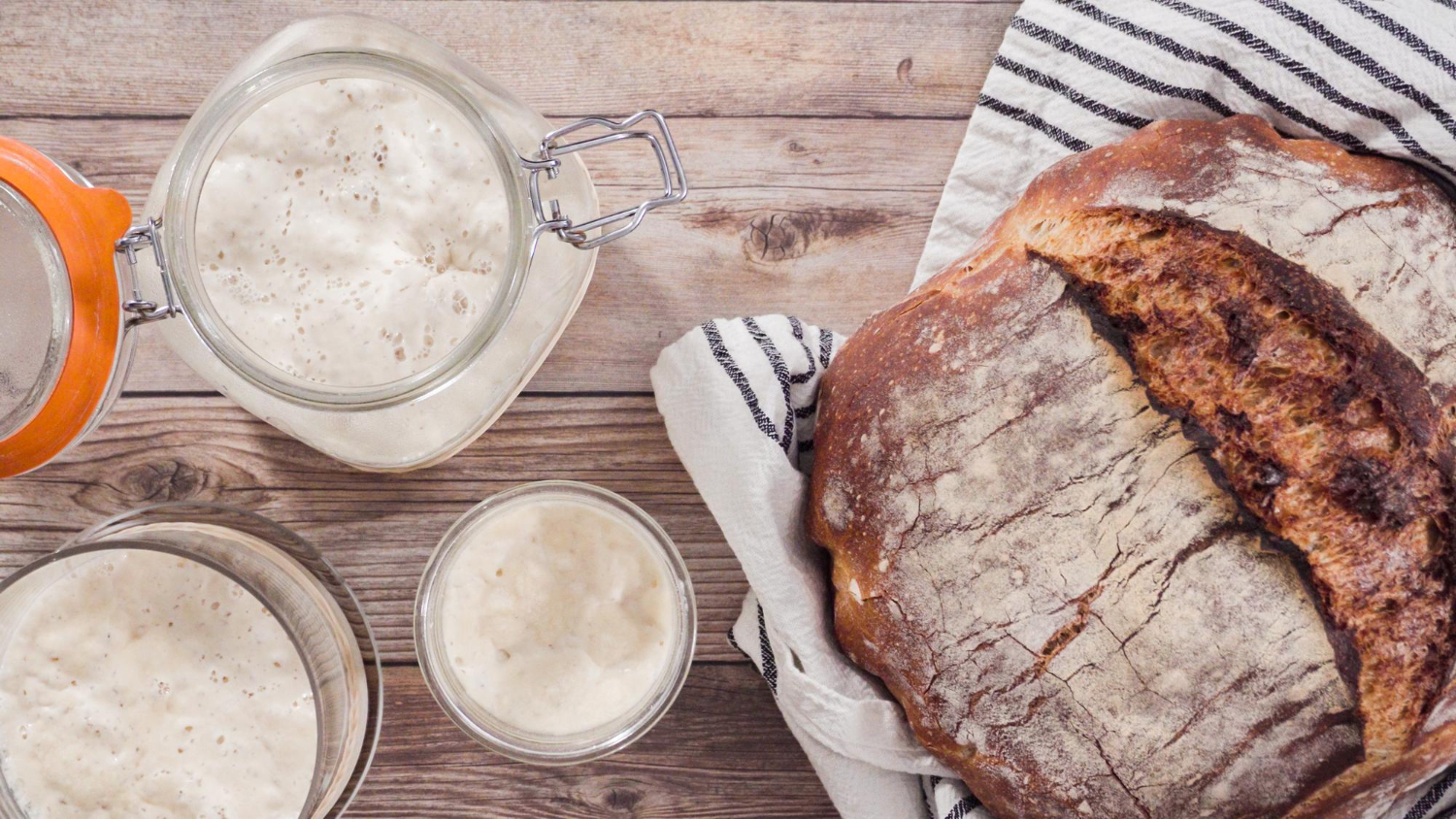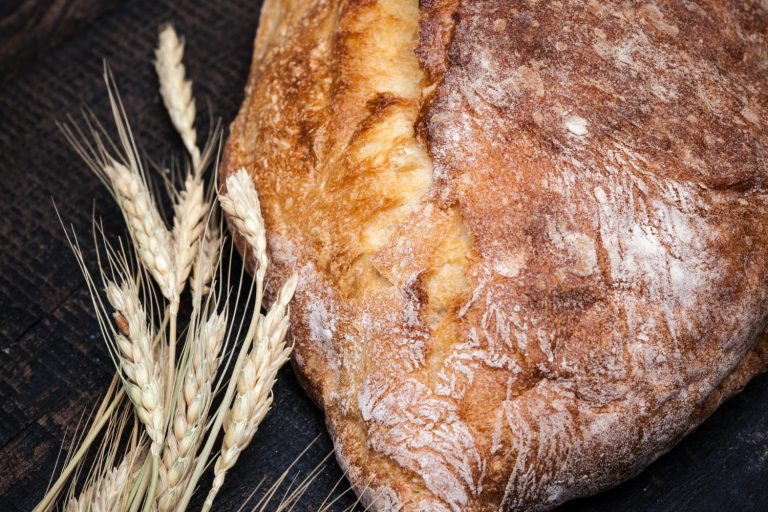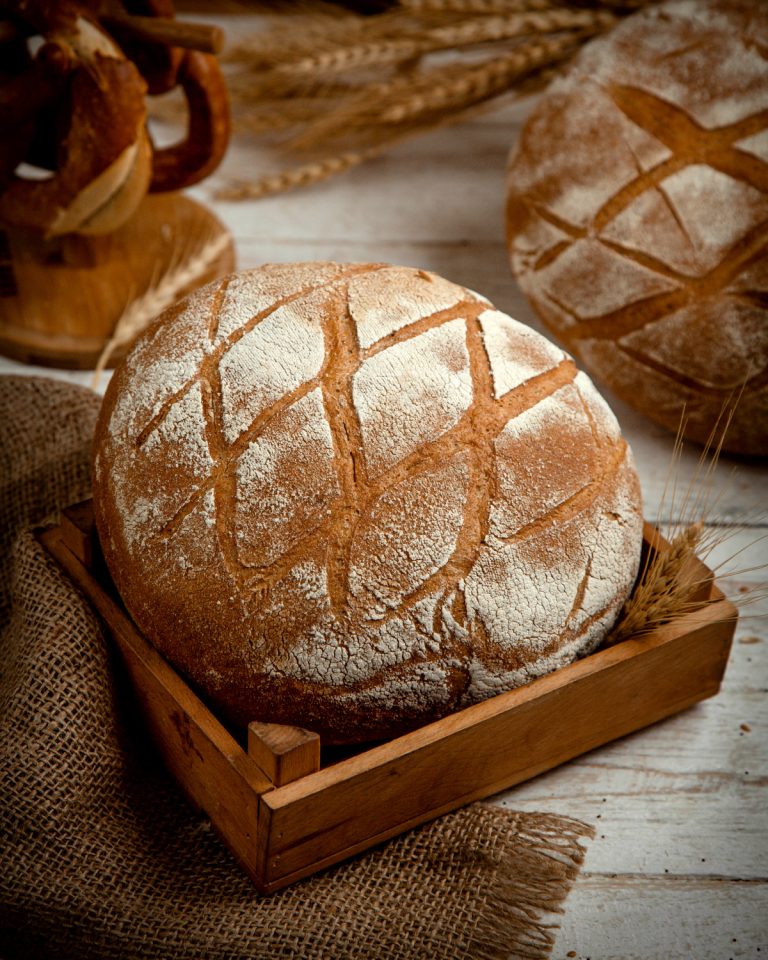How to Identify a Healthy Sourdough Starter Smell: Good vs Bad Signs
Your sourdough starter‘s smell is vital to its health and readiness to bake. Home bakers often find it challenging to tell if their starter’s smell indicates success or trouble. These distinct aromas help you create a thriving starter that produces better-baked goods.
Healthy starters can give off several everyday scents that range from pleasant yeasty notes to mild vinegar or alcohol aromas. This piece helps you spot the difference between excellent and lousy starter smells. You’ll learn about common problems like acetone odors and find budget-friendly ways to keep your starter healthy through proper feeding schedules and temperature control. You’ll also discover warning signs and learn how to fix common starter issues quickly.
The Ideal Sourdough Starter Smell
The ideal sourdough starter smell is vital to successful breadmaking. A starter that is adequately kept develops distinct aromas that show its health and readiness to bake.
Yeasty and slightly sour aroma
A healthy sourdough starter’s aroma features a fresh, yeasty smell with subtle astringent notes. The name might suggest otherwise, but a quality starter won’t smell sour. You’ll notice an aroma similar to fresh bread dough with just a hint of tanginess. This balanced fragrance shows that beneficial yeasts and bacteria coexist perfectly in the culture.
Hints of fermentation
The fermentation process releases various aromas that change and develop over time. Bakers can detect several distinct scents during the early stages:
- Sweet or fruity fragrances
- Mild yogurt-like tanginess
- Pleasant earthy undertones
- Subtle beer-like notes
These scents show that your starter is fermenting properly. As the fermentation continues, your starter’s aroma will become more robust and complex.
Pleasant, bread-like scent
A mature and stable starter should have a pleasant bread-like scent. This signature aroma includes:
- Sweet with a subtle sour note
- Reminiscent of fresh yeast
- Clean and appetizing
- Neither too firm nor too mild
A mature starter produces a more stable and consistent smell than younger cultures. The perfect aroma should remind you of freshly baked bread without being overwhelming. This distinctive smell emerges when the starter matures and builds a strong colony of beneficial microorganisms.
Healthy starters can have slightly different aromas based on flour types and environmental conditions. The smell naturally changes throughout the feeding cycle, but a thriving culture always returns to that pleasant, bread-like scent.
Your starter won’t develop these ideal aromas immediately. New starters pass through several small stages before reaching their best state. Regular feeding and patience help create and maintain these desired aromatic qualities.
Signs of a Healthy Sourdough Starter
You can spot a thriving sourdough culture by looking at its appearance and smell. A starter that has managed to keep well-maintained starter shows clear signs when it’s ready to use in baking.
Consistent bubbling and rise
A healthy sourdough starter shows predictable fermentation patterns through active behavior. These reliable signs include:
- The starter doubles or triples in size after each feeding
- Bubbles form evenly throughout the mixture
- An elastic band shows clear signs of rise
- The peak height stays steady
- A dome forms at peak activity
Bubble sizes change based on hydration levels and flour types, but this doesn’t affect the starter’s health. Starters with more liquid create smaller bubbles, while thicker starters produce more giant bubbles that last longer between feedings.
Sweet-sour smell
A healthy starter’s aroma evolves with maturity and develops a complex profile that shows proper fermentation. A starter that’s managed to keep its health produces fresh, fruity notes that come off my head like pleasant scents. You might detect hints of toasted coconut or pineapple, while some starters give off an apple or cinnamon undertones.
Temperature is a vital part of aroma development. Optimal warmth stimulates beneficial bacteria and leads to proper fermentation that creates desirable scents. The sweet-sour balance should stay consistent through the feeding cycle, though slight variations naturally occur.
Tangy but not overpowering odor
A mature starter has a balanced aroma profile that won’t overwhelm your senses. The tanginess should be noticeable yet controlled, which suggests a healthy balance between wild yeast and beneficial bacteria. These microorganisms work together to create the perfect environment for proper fermentation and flavor.
Your starter’s feeding schedule directly affects the strength of its tangy smell. A starter with regular feeds produces a pleasant aroma, while an underfed one might develop stronger scents. You can keep this optimal balance with consistent feeding schedules that help your starter stay in prime baking condition.
Temperature substantially affects your starter’s behavior and smell. If you keep your starter consistently warm, it will show predictable rises and stable aromas. A healthy starter at ideal temperatures displays steady activity levels and keeps its pleasant smell between feeds.
Red Flags: Bad Smells to Watch Out For
The aromas from a sourdough starter can signal the biggest problems that need attention. Bakers who recognize these warning signs can maintain a healthy culture and prevent their starter from failing.
Acetone or nail polish remover scent
Your sourdough starter might smell like acetone when the yeast becomes stressed. This chemical smell can show up during any feeding stage because of several reasons:
- Temperatures that go above 80°F/27°C
- Too much water content
- The culture’s high acid levels
- Not enough regular feedings
- Unbalanced microbes
- Young starter that needs time
New starters under 30 days old tend to have this acetone smell more often. The good news is that this smell usually disappears as your starter gets older and more established. Important note: You won’t taste any acetone in your finished bread since it completely evaporates during baking.
Rotten or putrid odors
A sourdough starter with distinctly unpleasant smells like rotting meat or stinky feet shows severe contamination. These foul odors emerge from:
- Extended neglect
- Inappropriate storage temperatures
- Harmful bacteria overgrowth
If putrid smells develop, the starter needs immediate disposal. These odors indicate unsafe conditions that regular feeding or maintenance cannot fix.
Strong alcohol smell
A mild alcohol aroma naturally occurs during fermentation as yeast produces it. But an overwhelming alcohol smell with a transparent liquid layer called “hooch” shows that your starter is hungry. You’ll notice this happening when:
- Your starter has fallen entirely flat
- The starter has used up all flour
- You’ve left the culture unfed too long
- The storage area is too warm
Bakers can fix strong alcohol smells by:
- Getting rid of any hooch buildup
- Feeding the starter more often
- Finding a more excellent spot for storage
- Making changes to the flour-to-water ratio
A slight alcohol smell won’t hurt your starter, but intense alcohol aromas can damage the good bacteria and yeast population over time. The proper feeding schedule and temperature control will keep fermentation byproducts appropriately balanced.
Your refrigerated starter might develop a hooch layer, which is perfectly normal. But if you notice other strange smells along with it, your starter might need more frequent feeds or a different environment. Note that a vinegar smell typically means your yeast is starving and bacteria have started taking over the culture.
How Starter Age Affects Smell
A sourdough culture‘s age plays a significant role in its characteristic aromas and undergoes distinct changes during development. Bakers who understand these transitions can better anticipate and manage their starter’s progress.
Young starter vs. mature starter scents
Young sourdough starters produce more volatile and unpredictable aromas than their mature counterparts. A baker might notice these distinct characteristics during the starter’s early stages:
- Sweet or fruity fragrances
- Milky or creamy notes
- Buttery undertones
- Variable intensity levels
Mature starters develop a consistent profile in which heterofermentative lactic acid bacteria dominate. These 6-month-old cultures generate stronger sour notes from increased acetic acid production and create a complex, stable aromatic profile.
Changes in aroma over time
A starter’s smell reflects its developing microbial community as time passes. Early fermentation creates different intensities of aromas when various microorganisms compete to dominate. This natural process can create strong temporary smells such as:
- Yeasty overtones
- Mild alcohol notes
- Temporary acetone scents
- Varying degrees of sourness
Warmer conditions (below 80°F/27°C) speed the development process and greatly influence these changes. The microbial balance moves toward stability, and the aromas become more predictable as beneficial bacteria establish their presence.
A Stable Smell Takes Time
Your sourdough starter develops its signature aroma about 30 days after you maintain it regularly. The culture needs this time to build a balanced ecosystem of yeast and bacteria. Here’s what affects how quickly your starter stabilizes:
Feeding Schedule Consistency
- Your starter stabilizes faster with regular feedings
- Balanced ratios create the right bacterial mix
- The right amount of water leads to better fermentation
Environmental Conditions
- Steady temperatures help even development
- Good airflow shapes the aroma
- Storage methods determine bacterial growth
Your new starter might initially smell like acetone, but this scent usually fades as it matures. This change shows that a healthy microbial community has taken root. Some starters might keep slight acetone notes that add to their character, but these shouldn’t overpower the primary aroma.
A stable smell needs patience and steady care. A mature starter ready to bake will keep its distinctive aroma with minor changes between feedings. This consistency tells you that your starter is healthy and ready to use.
Starters made with white flour smell milder than those made with whole grains. Your starter’s smell might change temporarily if you switch flours, but a mature culture usually returns to its typical aroma after a few feedings.
Troubleshooting Common Smell Issues
A sourdough starter needs specific conditions to develop its signature aromas. Bakers can adjust three areas to fix minor problems and keep their starters healthy.
Adjusting feeding schedule
A well-planned feeding routine maintains the delicate balance of microorganisms that create desirable aromas. These feeding adjustments help resolve smell issues:
- Increase feeding frequency if you notice:
- Strong acetone odors
- Overwhelming alcohol smells
- Excessive hooch formation
- Sharp vinegar notes
The ripe starter’s carryover amount affects fermentation speed by a lot. Warmer conditions need only 5 grams of carryover to prevent over-fermentation. Colder temperatures might need up to 25 grams to maintain optimal activity.
Changing flour types
Your starter’s behavior and aroma profile changes significantly based on your chosen flour. Whole grain flours provide more nutrients and organisms that feed beneficial bacteria; refined flours create milder scents. Here’s what you need to know at the time you switch flour types:
- Your starter needs 1-2 weeks to adapt to new flour
- You might want to blend old and new flour types
- A small amount of whole rye flour boosts activity
- Start with a small portion of starter to test new flours
Important note: Your starter becomes wetter and flatter with all-purpose flour compared to other varieties, but it still maintains vigorous fermentation activity. Whole-grain rye flour is an excellent choice to increase fermentation activity and create a lively starter.
Temperature considerations
Temperature management is vital to keeping your fermentation proper and preventing bad odors. Here’s what you need to know about keeping your starter healthy:
- Keep temperature between 70-75°F (21-24°C) for regular maintenance
- Your starter shouldn’t go above 90°F (32°C) because it creates too much acid
- Store at 42-50°F (5.5-10°C) to maintain long-term
- Your starter will die at temperatures above 130°F (54°C)
Refrigeration helps you avoid over-fermentation and preserves those admirable aromatic qualities during summer. Your refrigerated starter needs weekly feeding to stay alive. Temperature fluctuations significantly affect your starter’s behavior, so keeping it steady makes all the difference.
Starters that show signs of stress usually bounce back with a mix of these adjustments. A starter that smells like acetone responds well to more frequent feeding and the right temperature. The smell of alcohol means your starter is hungry and needs more frequent feeds rather than different flour.
Gradual adjustments work better than big changes when you’re fixing ongoing smell problems. This gives your starter’s microbes time to adapt without extra stress. You’ll find the best mix of solutions by watching how your starter responds to each change.
Seasonal changes and kitchen conditions might mean you need to adjust things occasionally to keep your starter at its best. Watch it closely and fix minor problems before they become big ones.
Maintaining a Healthy-Smelling Starter
A sourdough starter needs consistent care, proper storage conditions, and regular cleaning to thrive. Bakers who keep their starters healthy are rewarded with reliable performance and pleasant aromas that indicate perfect fermentation.
Proper feeding techniques
A consistent feeding routine helps your sourdough starter smell fresh and healthy. A mature starter works best with these proportions:
| Component | Amount | Percentage |
|---|---|---|
| Ripe starter | 20g | 20% |
| All-purpose flour | 70g | 70% |
| Whole rye flour | 30g | 30% |
| Water | 100g | 100% |
Your daily starter maintenance at room temperature (76°F/24°C) should look like this:
- Remove excess starter, leaving 20g
- Add fresh flour mixture (70g all-purpose, 30g whole rye)
- Incorporate 100g room temperature water
- Mix everything well until smooth
- Cover loosely and let rest for 12 hours
In the summer heat, you should reduce your carryover starter to 5g to prevent over-fermentation. You might need up to 25g on cold winter days to keep your starter active enough.
Storage best practices
Your starter’s aroma and performance depends on how you store it. Temperature control is a vital part of keeping those desirable smells. Bakers who store starters at room temperature should follow these guidelines:
- Keep the environment between 75-78°F (24-26°C)
- Feed twice daily at 12-hour intervals
- Use a loose-fitting lid so air can circulate
- Watch activity levels and adjust feeding based on observations
- Keep ambient conditions steady
Refrigerated storage requires different handling methods. The starter needs to be fed before it goes into the refrigerator and should be fed weekly after that. This approach works best if you bake bread less than twice weekly.
Your choice of container substantially affects your starter’s health. Glass containers work better than plastic because they don’t hold onto odors or absorb chemicals. A wide-mouthed mason jar that lets your starter double in volume creates perfect conditions for growth.
Regular cleaning of the container
A clean environment matters, but too much cleaning can harm the beneficial bacteria colony. Your starter does better when it stays in the same container. This creates a stable environment for wild yeast and bacteria to thrive.
Basic maintenance steps include:
- Use a rubber spatula to scrape down the jar sides
- Wipe the rim with paper towels after feeding
- Remove any dried starter from the exterior
- Watch for crusty buildup that might stop the lid from closing properly
You’ll need to do a deep clean occasionally. Temporarily move your starter to a clean bowl. Clean the container with hot water and mild dish soap. Rinse it well to remove all soap residue. Let the jar air dry completely before putting your starter back.
Long-term storage needs extra care. You can keep your starter healthy by:
- Reducing hydration levels before refrigeration
- Making the starter consistency stiff for storage
- Letting it ferment at room temperature for an hour before refrigeration
- Keeping it sealed but not airtight
Temperature fluctuations significantly affect your starter’s health and aroma. Your starter thrives best in steady conditions that help balance beneficial bacteria and wild yeast. When you move it between storage temperatures, the culture needs time to adapt gradually.
A gray layer called hooch means your starter is hungry, not spoiled. Just pour off the liquid and feed as usual. Refrigerated starters form hooch more often, but your starter is fine if it smells pleasant.
Strong acetone or alcohol smells usually mean your starter needs more frequent feeding. These odors show your starter is underfed rather than contaminated. Good maintenance and proper storage prevent these problems.
Mature starters thrive on regular feeding schedules and steady conditions. The smell might change during feeding cycles – that’s normal. Your starter will keep its pleasant aroma if you use proper techniques. Watch your starter closely and adjust feeding and storage to keep it healthy and performing well.
Conclusion
Knowing how to spot and understand sourdough starter aromas will make you a better bread baker. Your starter should have a sweet-sour smell and show consistent bubbling with proper rise. These signs indicate optimal fermentation activity and tell you when it’s ready to bake. Bakers use these smell indicators and visual clues to keep the perfect balance of beneficial microorganisms that significant sourdough needs.
Your starter needs proper feeding schedules, temperature, and storage to stay healthy and smell right. You should address any odd odors quickly to prevent problems and keep your starter’s health in check for reliable results. Bakers who need more guidance can find detailed resources at The Yeast We Can Do. Their expert advice helps you develop thriving sourdough cultures that make exceptional bread.
FAQs
What does a healthy sourdough starter typically smell like?
A healthy sourdough starter usually emits a floury aroma right after being fed, as it primarily consists of flour and water. As it rises, it may develop a ripe or sweet scent reminiscent of ripe bananas, apples, or cantaloupe, a natural outcome of the sugars fermenting within the starter.
How can I determine if my sourdough starter is in good condition?
A well-maintained sourdough starter should be fluffy and slightly stretchy when you scoop a spoonful. It should also exhibit a pleasant, somewhat tangy smell. To maintain its health, consider increasing the frequency of feedings, especially in warmer temperatures, or try using the pineapple juice method to adjust its acidity.
What are the signs of a spoiled sourdough starter?
Spoilage in sourdough starters can be identified by unusual colors like pink, orange, green, white fuzzy spots, or dark areas with white on top. If you observe any of these signs, it’s safest to discard the starter and begin a new batch.
What should a vigorous and active sourdough starter look like?
An active sourdough starter should have doubled in volume after feeding and display numerous bubbles and a slightly foamy appearance on the surface. The aroma is equally important; it should smell yeasty and pleasantly sour.
What could cause my sourdough starter to smell bad or not show many bubbles?
Bad smells or a lack of bubbles in your sourdough starter could be due to it being too old and overwhelmed by its waste products like acid and alcohol, or it might be too young and not yet fully active. Regular feeding and maintaining an appropriate temperature are crucial for a healthy starter.
Is it normal for a sourdough starter to smell like vinegar or have a sharp, sour smell?
While a sourdough starter will naturally have a tangy or slightly sour smell due to fermentation, a robust vinegar-like smell might indicate over-fermentation or that it’s time to feed the starter. This can be managed by adjusting the hydration level and feeding frequency.
What should I do if my sourdough starter has a layer of liquid on top or smells like acetone?
A layer of liquid, known as ‘hooch,’ is standard and indicates that the starter is hungry. This can be stirred back in or poured off before feeding. If the starter smells like acetone, it may need more frequent feedings, especially if kept at room temperature.
How can I revive a neglected sourdough starter?
To revive a neglected starter, discard all but a small amount of the old starter, dissolve it in some filtered water, and feed it with flour. If the starter has been in the fridge, it should be fed at least once a week, and if at room temperature, it should be fed daily.






